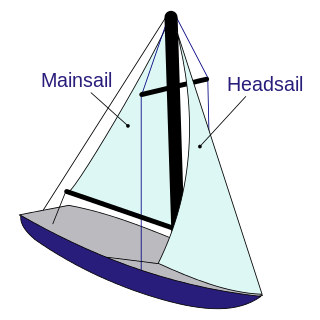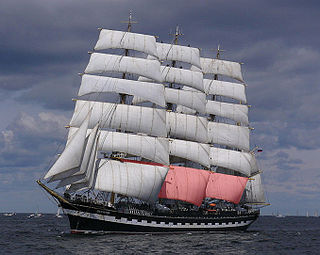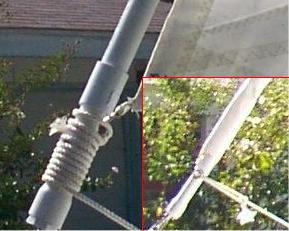
A sailboat or sailing boat is a boat propelled partly or entirely by sails and is smaller than a sailing ship. Distinctions in what constitutes a sailing boat and ship vary by region and maritime culture.

A sailing vessel's rig is its arrangement of masts, sails and rigging. Examples include a schooner rig, cutter rig, junk rig, etc. A rig may be broadly categorized as "fore-and-aft", "square", or a combination of both. Within the fore-and-aft category there is a variety of triangular and quadrilateral sail shapes. Spars or battens may be used to help shape a given kind of sail. Each rig may be described with a sail plan—formally, a drawing of a vessel, viewed from the side.
A jib is a triangular sail that sets ahead of the foremast of a sailing vessel. Its forward corner (tack) is fixed to the bowsprit, to the bows, or to the deck between the bowsprit and the foremost mast. Jibs and spinnakers are the two main types of headsails on a modern boat.

A jibe (US) or gybe (Britain) is a sailing maneuver whereby a sailing vessel reaching downwind turns its stern through the wind, which then exerts its force from the opposite side of the vessel. Because the mainsail boom can swing across the cockpit quickly, jibes are potentially dangerous to person and rigging compared to tacking. Therefore, accidental jibes are to be avoided while the proper technique must be applied so as to control the maneuver. For square-rigged ships, this maneuver is called wearing ship.

A staysail ("stays'l") is a fore-and-aft rigged sail whose luff can be affixed to a stay running forward from a mast to the deck, the bowsprit, or to another mast.

A spinnaker is a sail designed specifically for sailing off the wind on courses between a reach to downwind. Spinnakers are constructed of lightweight fabric, usually nylon, and are often brightly colored. They may be designed to perform best as either a reaching or a running spinnaker, by the shaping of the panels and seams. They are attached at only three points and said to be flown.

A mainsail is a sail rigged on the main mast of a sailing vessel.

A Bermuda rig, Bermudian rig, or Marconi rig is a configuration of mast and rigging for a type of sailboat and is the typical configuration for most modern sailboats. This configuration was developed in Bermuda in the 17th century; the term Marconi, a reference to the inventor of the radio, Guglielmo Marconi, became associated with this configuration in the early 20th century, because the wires that stabilize the mast of a Bermuda rig reminded observers of the wires on early radio masts.

Sail components include the features that define a sail's shape and function, plus its constituent parts from which it is manufactured. A sail may be classified in a variety of ways, including by its orientation to the vessel and its shape,. Sails are typically constructed out of flexible material that is shaped by various means, while in use, to offer an appropriate airfoil, according to the strength and apparent direction of the wind. A variety of features and fittings allow the sail to be attached to lines and spars.
The Ross 930 is a class of fast cruiser-racer yachts named after its designer, New Zealander Murray Ross. The design is marked by light weight and moderate sail area, with a sail-area-to-displacement (SA/D) ratio of about 24, and displacement-to-length (D/L) ratio of 98. The bow section is quite narrow, providing relatively low wave-making resistance and reducing pounding while sailing upwind in waves, and the stern section is wide and flat, making the boat easy to control sailing fast downwind. The interior of the Ross 930 is comfortable, including fitted berths for five, a two-burner stove, galley with sink, and a head. The standard engine is an outboard in a well, but a few boats were built with small inboard diesel engines.

A gennaker is a sail that was developed around 1990. Used when sailing downwind, it is a cross between a genoa and a spinnaker. It is not symmetric like a true spinnaker but is asymmetric like a genoa, but the gennaker is not attached to the forestay like a jib or genoa. The gennaker is rigged like a spinnaker but the tack is fastened to the hull or to a bowsprit. It has greater camber than a genoa. This is optimal for generating lift at larger angles of attack. An early form of gennaker was the "gollywhomper", used briefly in the 1870s.

A fractional rig on a sailing vessel consists of a foresail, such as a jib or genoa sail, that does not reach all the way to the top of the mast.
A mast-aft rig is a sailboat sail-plan that uses a single mast set in the aft half of the hull. The mast supports fore-sails that may consist of a single jib, multiple staysails, or a crab claw sail. The mainsail is either small or completely absent. Mast-aft rigs are uncommon, but are found on a few custom, and production sailboats.

Roller furling is a method of furling a yacht's staysail by rolling the sail around a stay. Roller furling is typically used for foresails such as jibs or genoas.

The Laser 3000 is a racing sailing dinghy crewed by two persons with a trapeze for the crew. Launched in 1996, the 3000 was developed from the Laser 2, using the original Frank Bethwaite-designed planing hull combined with a brand new self-draining deck by Derek Clark. Clark also re-designed the rig, using spars and sails from premium proprietary sources and replacing the symmetric spinnaker of the Laser 2 by a larger asymmetrical spinnaker. The gennaker is chute-launched and retrieved using a single halyard line, and is set on a retractable bowsprit. Helm balance and handling were improved using a shorter-footed mainsail with two full-width battens giving a larger roach. A mast with conventional spreaders replaced the now-unusual diamond arrangement of the Laser 2.

The 3000 is a racing sailing dinghy crewed by two persons with a trapeze for the crew. Launched in 1996 as the Laser 3000, the 3000 was developed from the Laser 2, using the original Frank Bethwaite-designed planing hull combined with a new designed self-draining deck by Derek Clark. Clark also re-designed the rig, using spars and sails from premium proprietary sources and replacing the symmetric spinnaker of the Laser 2 by a larger asymmetric spinnaker (gennaker). The gennaker is chute-launched and retrieved using a single halyard line, and is set on a retractable bowsprit. Helm balance and handling were improved using a shorter-footed mainsail with two full-width battens giving a larger roach. A mast with conventional spreaders replaced the now-unusual diamond arrangement of the Laser 2.

An asymmetrical spinnaker is a sail used when sailing between about 90 and 165 degrees from the angle of the wind. Also known as an "asym", "aspin", or "A-sail" it can be described as a cross between a genoa jib and a spinnaker. It is asymmetric like a genoa, but like a spinnaker, its luff is unstructured; its leading edge is allowed to float freely, unencumbered by an internal wire or hanks attaching it to a stay. Unlike a symmetric spinnaker, the asymmetric does not require a spinnaker pole, since it is fixed (tacked) to the bow or bowsprit. The asymmetrical spinnaker has a larger camber than a genoa and a Spinnaker Mid-Gerth (SMG) -- also called Spinnaker Half Width (SHW) -- measurement greater than the length of its foot.

The Esse 990 is a 9.9-meter-long (32-foot) racing sportboat designed by Umberto Felci and built by Josef Schuchter Sportboats of Stafa, Switzerland. The first hull was sold in 2008 and series production was begun in 2009.
The following outline is provided as an overview of and topical guide to sailing:

A sail plan is a drawing of a sailing craft, viewed from the side, depicting its sails, the spars that carry them and some of the rigging that supports the rig. By extension, "sail plan" describes the arrangement of sails on a craft. A sailing craft may be waterborne, an iceboat, or a sail-powered land vehicle.


















